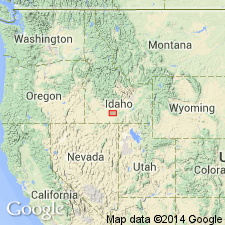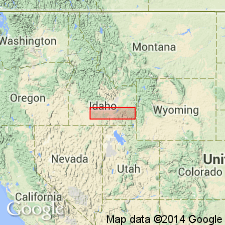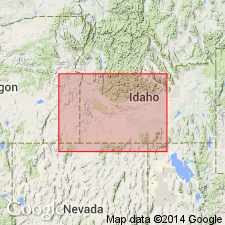
- Usage in publication:
-
- Shoshone Falls andesite*
- Modifications:
-
- Named
- Dominant lithology:
-
- Andesite
- AAPG geologic province:
-
- Snake River basin
Summary:
Type locality designated at Shoshone Falls, for which unit is probably named, located on Snake River in T9S, R18E, Twin Falls and Jerome Cos, ID, Snake River basin. Forms Shoshone Falls and Pillar Falls. Consists of greater than 200 ft of purple and black, massive, vitreous, porphyritic andesite. Overlies Paleozoic limestone; unconformably underlies Pillar Falls mud flow (new). Assigned Miocene? or late? Miocene age.
Source: GNU records (USGS DDS-6; Denver GNULEX).

- Usage in publication:
-
- Shoshone Falls andesite*
- Modifications:
-
- Overview
- AAPG geologic province:
-
- Snake River basin
Summary:
Mapped undifferentiated with overlying Pillar Falls mud flow; units exposed along banks of Snake River from Twin Falls (waterfall) downstream to area of Perrine ranch, Twin Falls and Jerome Cos, ID, Snake River basin, a distance of 6 mi. Recovery of Shoshone Falls from Twin Falls Cemetery well in sec 14, T10S, R17E, Twin Falls Co, indicates that unit extends at least 3 mi farther southeast than mapped and that it may be more than 450 ft thick. Consists of purple and black massive vitreous, porphyritic andesite; phenocrysts of oligoclase and andesine are tabular reaching up to 5 mm in length. Exposed thickness is about 200 ft. Younger than Miocene? rhyolitic rocks. Stratigraphic chart; geologic map. Assigned Miocene? or late Miocene? age.
Source: GNU records (USGS DDS-6; Denver GNULEX).

- Usage in publication:
-
- Shoshone Falls Andesite*†
- Modifications:
-
- Abandoned
Summary:
Abandoned in Snake River basin. [Reason not specified]. Replaced by Idavada Volcanics.
Source: GNU records (USGS DDS-6; Denver GNULEX).
For more information, please contact Nancy Stamm, Geologic Names Committee Secretary.
Asterisk (*) indicates published by U.S. Geological Survey authors.
"No current usage" (†) implies that a name has been abandoned or has fallen into disuse. Former usage and, if known, replacement name given in parentheses ( ).
Slash (/) indicates name conflicts with nomenclatural guidelines (CSN, 1933; ACSN, 1961, 1970; NACSN, 1983, 2005, 2021). May be explained within brackets ([ ]).

